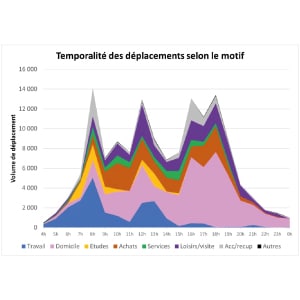Optimizing road safety through video analysis of risky behavior
Today, only 36% of French people consider cohabitation on the roads to be good, compared with 45% in 2023 and 50% in 2022. This drop in perception shows that road safety and user cohabitation have become priorities for rethinking our infrastructures.
Collecting and analyzing behavioral data on the roadway enables us to better understand risky practices and optimize traffic management and user safety. The minUi tool, based on video analysis, provides detailed data to help understand these phenomena. Here’s how it works.
Interfile traffic: making dense traffic safer
Interline traffic, where motorized or non-motorized two-wheelers circulate between lines of cars, is common in large cities. However, this practice, often tolerated but poorly regulated[1], presents numerous risks: collisions, lack of visibility, unpredictable behavior of other drivers, etc. Communities find it difficult to evaluate these practices due to the lack of reliable data and precise behavioral analyses. The challenge is to better understand where, how and under what conditions this practice becomes dangerous.
[1] An experiment is underway in 21 French departments for inter-line circulation of motorized two-wheelers. https://www.service-public.fr/particuliers/actualites/A15077
minUi makes it possible to precisely analyze inter-line traffic patterns through the analysis of vehicle flows, discriminating by mode. By identifying trajectories, risky behaviors, and points where accidents are likely to occur, minUi provides objective data. This information can be used by communities to adapt signage, review lane layout and possibly better regulate inter-lane traffic in road safety policies.
Wearing a helmet and distractors: optimizing the safety of vulnerable users
Wearing a helmet, although recommended (and compulsory for children under 12 years old) for cyclists and scooter users, is not always practiced. In addition, the use of distractors such as cell phones, prohibited by the highway code, increases the risk of accidents. Study managers often lack the tools to assess the extent of these risky behaviors.
minUi’s video analysis capabilities automatically detect soft modes and isolate them for in-depth analysis. Thus, in a semi-supervised manner, it is possible to categorize users with or without helmets, who use distractors, who are several on a bike or scooter, etc.
This data, collected over extended periods, gives study managers and decision-makers a better understanding of risky behaviors in different areas (cycle paths, shared paths, etc.), and helps them prioritize prevention actions and evaluate the effectiveness of the measures taken.
Dangerous pedestrian crossings: targeting risk areas
Pedestrian crossings outside protected crossings, often called “wild crossings”, represent a constant danger, particularly in dense urban areas. Pedestrians distracted by electronic devices or simply “rebellious”, poorly adapted infrastructure or poorly signaled crossings contribute to creating these dangerous situations. Local authorities often lack reliable data to identify high-risk areas and intervene proactively.
minUi, with its video processing, automatically displays areas where pedestrian crossings are frequent, thanks to user trajectories. This data allows communities to target areas requiring improvements (addition of signage, installation of protected passages) and to optimize urban development.
Annoying parking: reduce the impact on safety and traffic flow
“Uncontrolled” parking, particularly in sensitive areas such as intersections, emergency lanes or near schools, causes disruption and can quickly become accident-prone. By blocking visibility or obstructing important traffic lanes, these offenses endanger pedestrians and cyclists, while worsening traffic jams.
However, it is often difficult for authorities to effectively monitor these areas in real time or retrospectively, and to precisely measure the extent of the phenomenon.
minUi automatically detects offending vehicles in specific areas (crossroads, schools, etc.). The tool generates occupancy statistics and presence time in this area, and can also generate real-time alerts. By analyzing these parking behaviors, minUi provides actionable data on violation frequency and hotspots. This allows communities to intervene in a targeted manner, whether to strengthen controls or as part of an evaluation phase of the development of these areas.
Conclusion and Perspectives
Securing the city means improving the use of active modes, it means decarbonizing mobility. Having the data and operating tools to accurately identify risky behaviors is essential to making informed decisions and reducing accidents. minUi offers a reliable solution by providing indicators on practices such as cross-lane traffic, helmet use, dangerous pedestrian crossings and illegal parking.
The Ministry of the Interior, in collaboration with Cerema, also uses the measurements generated by minUi to supply the National Interministerial Road Safety Observatory (ONISR) with valuable statistics on risky behavior and guide future decisions.

- Publié le
Do you want to study the feasibility of a security project to analyze behavior with minUi?
Let's plan a discussion about your projects: contact us!








